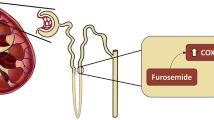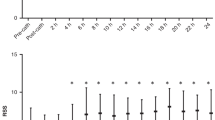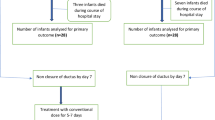Abstract
Objective:
Following patent ductus arteriosus (PDA) ligation, preterm infants may develop profound hypotension and respiratory failure. Prophylactic stress hydrocortisone (HC) has emerged as a therapy to prevent complications, postulating these infants do not synthesize steroids because of an immature hypothalamic–pituitary–adrenal axis. The purpose of this study was to compare outcomes in infants who received stress HC before their PDA ligations to those who did not.
Study Design:
A retrospective chart review was performed of infants who underwent PDA ligations at our institution's neonatal intensive care unit. Data were collected on treatment with HC, and respiratory and cardiovascular support.
Result:
Gestational age (GA) and birth weight were lower in the HC group (24 vs 25 weeks, 632 vs 790 g), but age at time of surgery was similar (26 vs 21 days). Cardiorespiratory support was comparable between the groups pre- and post-operatively. In regression models that adjusted for GA, HC treatment was not independently related to respiratory support postoperatively, but was associated with a decrease in postoperative dopamine (2.2 mcg kg−1 min−1; P=0.03). Respiratory support postoperatively was predicted by preoperative respiratory support. GA and age at surgery were not independently associated with outcome.
Conclusion:
Preoperative stress HC was not associated with improved cardiorespiratory stability, regardless of GA. Further investigation is needed to identify infants who may benefit from this therapy.
This is a preview of subscription content, access via your institution
Access options
Subscribe to this journal
Receive 12 print issues and online access
$259.00 per year
only $21.58 per issue
Buy this article
- Purchase on Springer Link
- Instant access to full article PDF
Prices may be subject to local taxes which are calculated during checkout
Similar content being viewed by others
References
Lee GY, Sohn YB, Kim MJ, Jeon GW, Shim JW, Chang YS et al. Outcome following surgical closure of patent ductus arteriosus in very low birth weight infants in neonatal intensive care unit. Yonsei Med J 2008; 49 (2): 265–271.
Raval MV, Laughon MM, Bose CL, Phillips JD . Patent ductus arteriosus ligation in premature infants: who really benefits, and at what cost? J Pediatr Surg 2007; 42 (1): 69–75; discussion 75.
Naik-Mathuria B, Chang S, Fitch ME, Westhoff J, Brandt ML, Ayres NA et al. Patent ductus arteriosus ligation in neonates: preoperative predictors of poor postoperative outcomes. J Pediatr Surg 2008; 43 (6): 1100–1105.
Teixeira LS, Shivananda SP, Stephens D, Van Arsdell G, McNamara PJ . Postoperative cardiorespiratory instability following ligation of the preterm ductus arteriosus is related to early need for intervention. J Perinatol 2008; 28 (12): 803–810.
Harting MT, Blakely ML, Cox Jr CS, Lantin-Hermoso R, Andrassy RJ, Lally KP . Acute hemodynamic decompensation following patent ductus arteriosus ligation in premature infants. J Invest Surg 2008; 21 (3): 133–138.
Doyle LW . Outcome at 5 years of age of children 23 to 27 weeks’ gestation: refining the prognosis. Pediatrics 2001; 108 (1): 134–141.
Kabra NS, Schmidt B, Roberts RS, Doyle LW, Papile L, Fanaroff A . Neurosensory impairment after surgical closure of patent ductus arteriosus in extremely low birth weight infants: results from the Trial of Indomethacin Prophylaxis in Preterms. J Pediatr 2007; 150 (3): 229–234, 234 e1.
Watterberg KL, Gerdes JS, Cole CH, Aucott SW, Thilo EH, Mammel MC et al. Prophylaxis of early adrenal insufficiency to prevent bronchopulmonary dysplasia: a multicenter trial. Pediatrics 2004; 114 (6): 1649–1657.
Ng PC, Lee CH, Bnur FL, Chan IH, Lee AW, Wong E et al. A double-blind, randomized, controlled study of a “stress dose” of hydrocortisone for rescue treatment of refractory hypotension in preterm infants. Pediatrics 2006; 117 (2): 367–375.
Baker CF, Barks JD, Engmann C, Vazquez DM, Neal Jr CR, Schumacher RE et al. Hydrocortisone administration for the treatment of refractory hypotension in critically ill newborns. J Perinatol 2008; 28 (6): 412–419.
Seri I, Tan R, Evans J . Cardiovascular effects of hydrocortisone in preterm infants with pressor-resistant hypotension. Pediatrics 2001; 107 (5): 1070–1074.
Finer NN, Powers RJ, Ou CH, Durand D, Wirtschafter D, Gould JB . Prospective evaluation of postnatal steroid administration: a 1-year experience from the California Perinatal Quality Care Collaborative. Pediatrics 2006; 117 (3): 704–713.
Noori S, Friedlich P, Seri I, Wong P . Changes in myocardial function and hemodynamics after ligation of the ductus arteriosus in preterm infants. J Pediatr 2007; 150 (6): 597–602.
Taylor AF, Morrow WR, Lally KP, Kinsella JP, Gerstmann DR, deLemos RA . Left ventricular dysfunction following ligation of the ductus arteriosus in the preterm baboon. J Surg Res 1990; 48 (6): 590–596.
Aucott SW, Watterberg KL, Shaffer ML, Donohue PK . Do cortisol concentrations predict short-term outcomes in extremely low birth weight infants? Pediatrics 2008; 122 (4): 775–781.
Masumoto K, Kusuda S, Aoyagi H, Tamura Y, Obonai T, Yamasaki C et al. Comparison of serum cortisol concentrations in preterm infants with or without late-onset circulatory collapse due to adrenal insufficiency of prematurity. Pediatr Res 2008; 63 (6): 686–690.
Yoder B, Martin H, McCurnin DC, Coalson JJ . Impaired urinary cortisol excretion and early cardiopulmonary dysfunction in immature baboons. Pediatr Res 2002; 51 (4): 426–432.
Moin F, Kennedy KA, Moya FR . Risk factors predicting vasopressor use after patent ductus arteriosus ligation. Am J Perinatol 2003; 20 (6): 313–320.
Author information
Authors and Affiliations
Corresponding author
Ethics declarations
Competing interests
The authors declare no conflict of interest.
Rights and permissions
About this article
Cite this article
Satpute, M., Donohue, P., Vricella, L. et al. Cardiovascular instability after patent ductus arteriosus ligation in preterm infants: the role of hydrocortisone. J Perinatol 32, 685–689 (2012). https://doi.org/10.1038/jp.2011.166
Received:
Revised:
Accepted:
Published:
Issue Date:
DOI: https://doi.org/10.1038/jp.2011.166
Keywords
This article is cited by
-
Post-ligation cardiac syndrome is associated with increased morbidity in preterm infants
Journal of Perinatology (2018)



